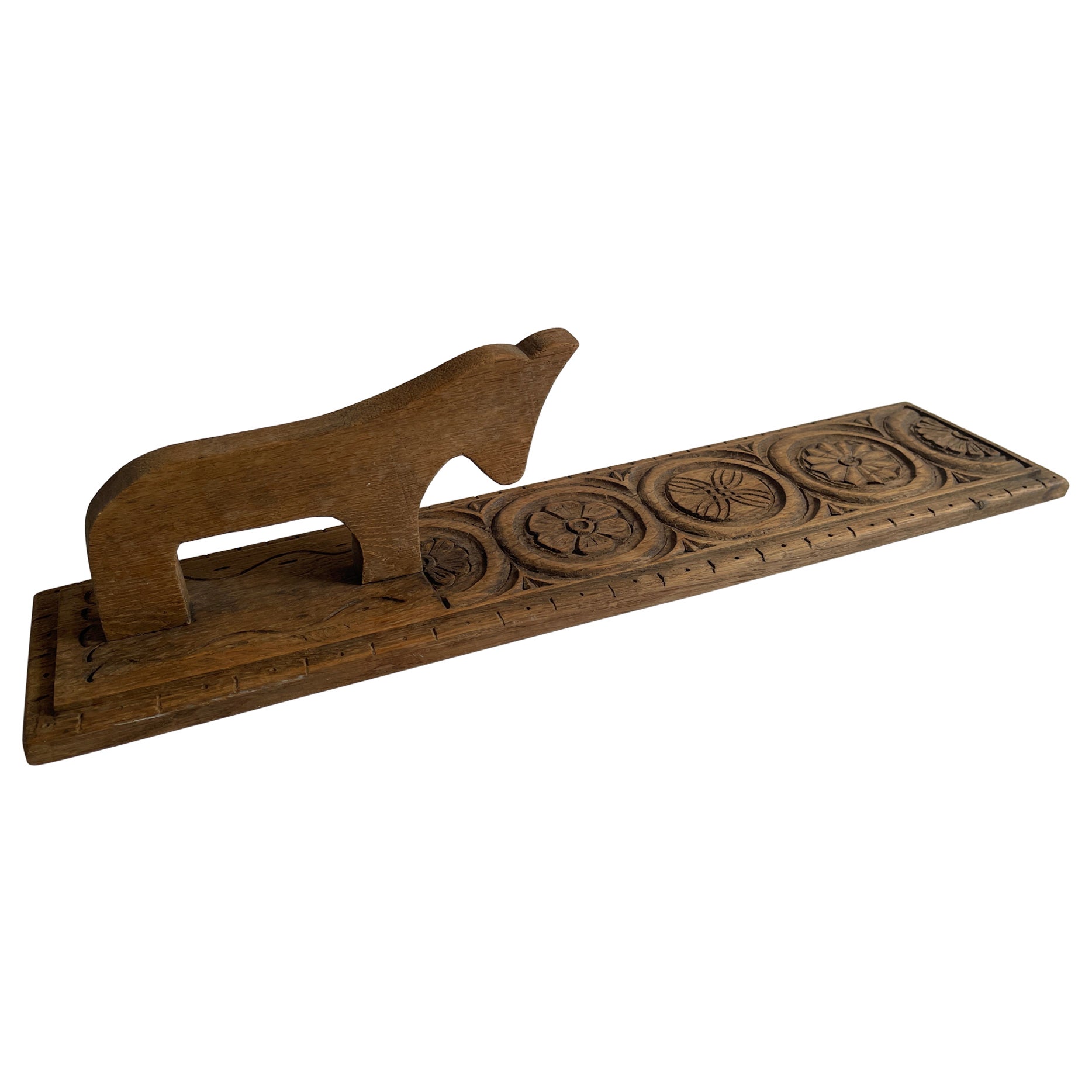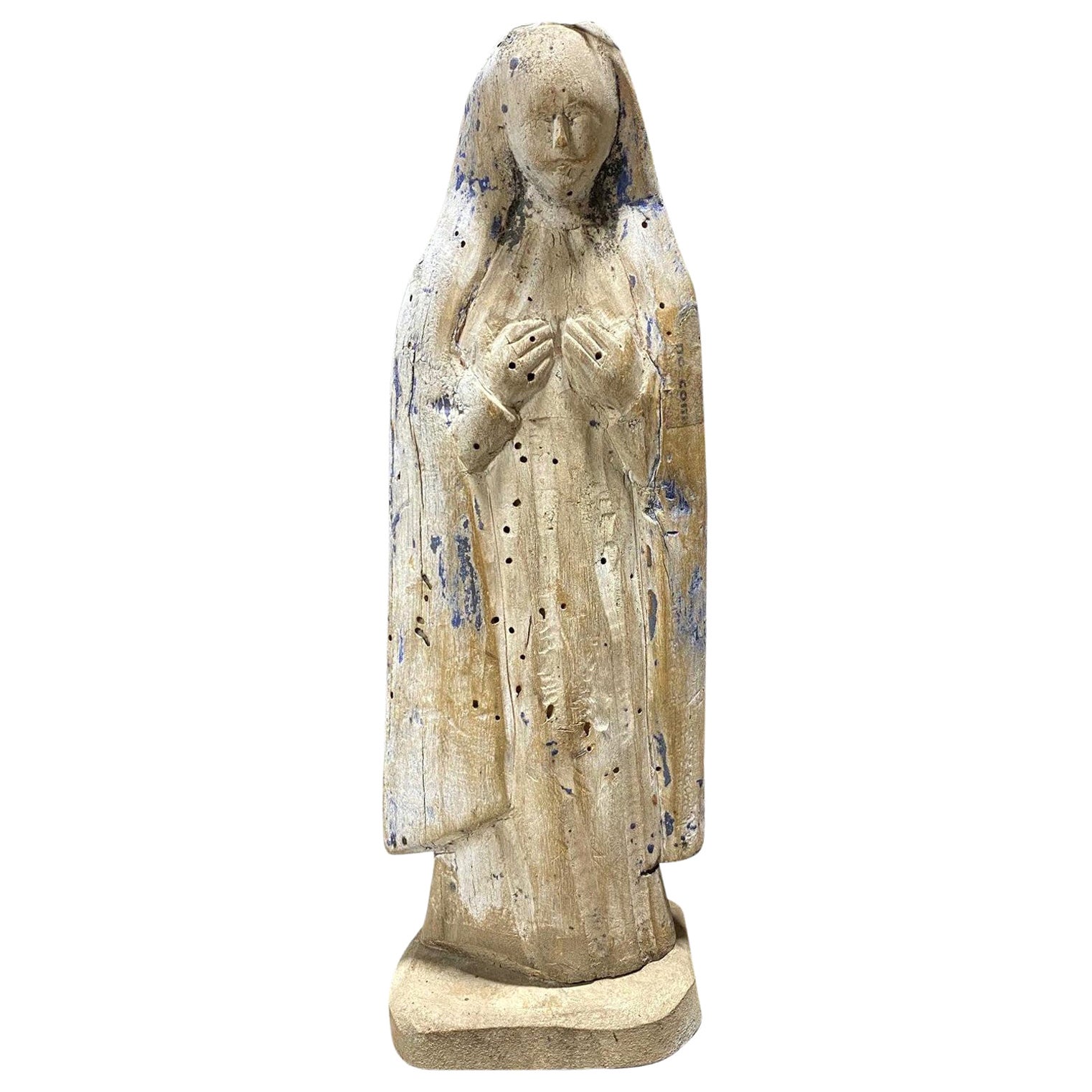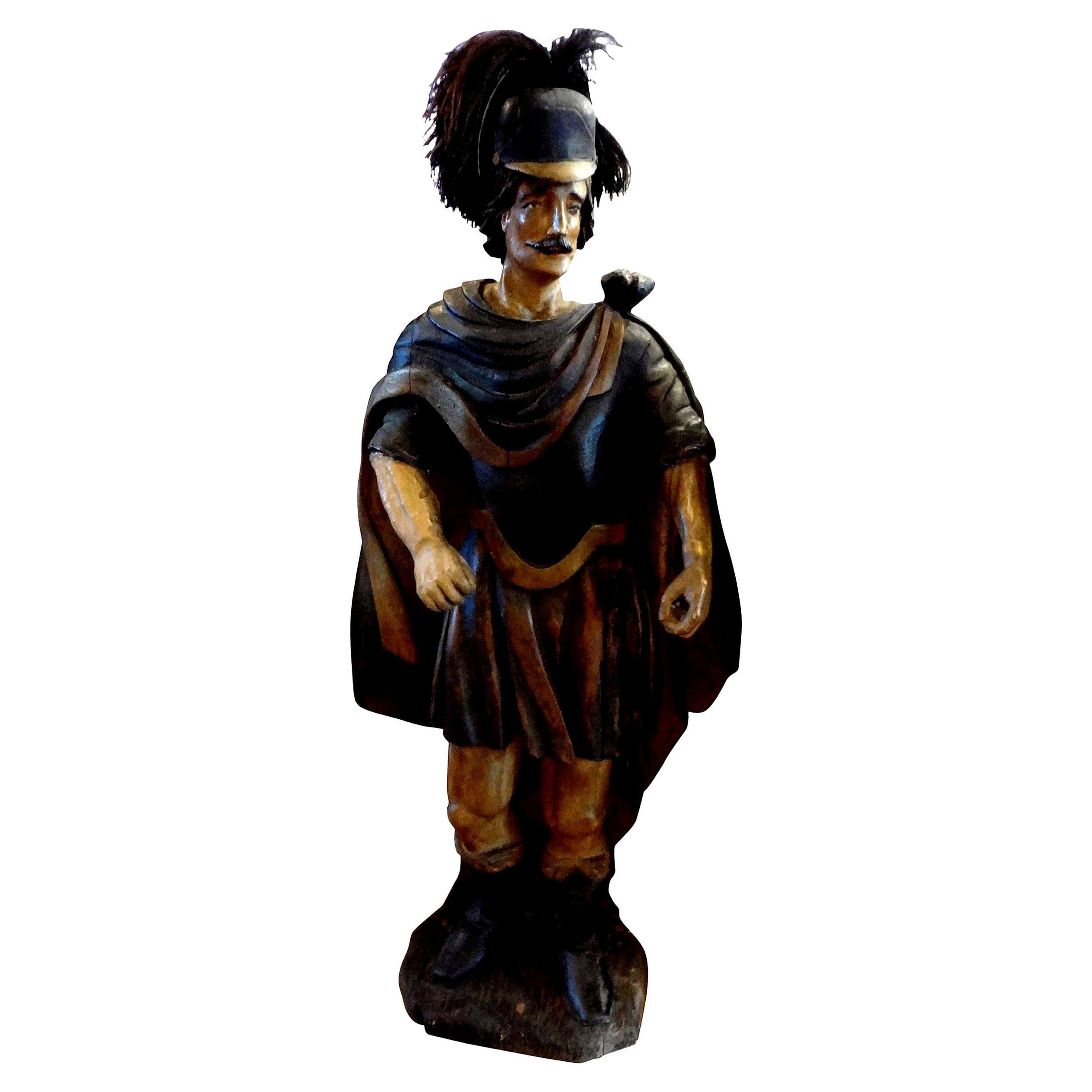Items Similar to 18th Century Swedish Carved Mangle Board
Want more images or videos?
Request additional images or videos from the seller
1 of 7
18th Century Swedish Carved Mangle Board
About the Item
A long hand carved wooden mangle board (clothing and bedding press) with beautiful patina.
Handmade in Sweden, circa 1744, this Scandinavian antique with sculptural stylized horse handle, accented with finely incised detailing, flanked by five compass-drawn decorative circles on the single board plank.
Signed panel across center, most likey a wedding gift labeled with the two newly wed's initials, "ANOSPD" and dated 1744.
Having a richly decorated top section featuring various complex geometric pattern relief carvings focused around five large overlapping mandala style circles.
The verso with a wonderfully aged worn smooth finish, affixed with later metal bracket for wall hanging.
Provenance:
A prestigious Greenwich, CT private estate
Dimensions: (approx)
23.5" Long, 5.25" High, 6.25" Wide narrowing to 5" Wide
Museum quality condition;
This rare pre-Gustavian folk art work is in excellent shape, completely original, it's solid, sturdy and structurally sound. Enhanced by attractive patina over the whole, highly desirable well worn, naturally distressed finish, with age related splits along the ends, and minor losses to corners and edges, all wear consistent with age and use, with nothing that detracts from the overall display or functionality, but only adds to the authenticity, antique character, rustic charm and elegant warmth that can only be acquired from a life of almost three centuries.
- Dimensions:Height: 5.25 in (13.34 cm)Width: 23.5 in (59.69 cm)Depth: 6.25 in (15.88 cm)
- Style:Primitive (In the Style Of)
- Materials and Techniques:
- Place of Origin:
- Period:
- Date of Manufacture:1744
- Condition:Wear consistent with age and use. Minor losses. Excellent shape, completely original, it's solid, sturdy and structurally sound. Enhanced by attractive patina over the whole, highly desirable well worn, naturally distressed finish, with age related splits along the ends, and minor losses to corner.
- Seller Location:Forney, TX
- Reference Number:1stDibs: LU5977226683312
About the Seller
4.8
Platinum Seller
These expertly vetted sellers are 1stDibs' most experienced sellers and are rated highest by our customers.
Established in 2013
1stDibs seller since 2021
199 sales on 1stDibs
Typical response time: <1 hour
- ShippingRetrieving quote...Ships From: Forney, TX
- Return PolicyA return for this item may be initiated within 7 days of delivery.
More From This SellerView All
- 18th/19th Century Spanish Colonial Carved Polychrome Wood Santo Altar SculptureLocated in Forney, TXA most impressive antique Spanish Colonial hand carved polychromed wood Santo Catholic church altar figure. circa 1800 Hand-crafted in the late 18th / early 19th century, exceptionally executed intricate detailing, the large scale antique religious sculpture depicting the female Saint Teresa of Avila, polychrome painted gesso over finely sculpted wood, inset glass eyes, shown in Carmelite nun habit...Category
Antique Late 18th Century Spanish Colonial Sculptures and Carvings
MaterialsGesso, Wood, Paint
- 18th/19th Century Italian Baroque Silvered Metal Altar Monstrance ReliquaryLocated in Forney, TXA stunning antique Italian Baroque style silvered metal gilded wood monstrance reliquary. circa 1770-1820 Handmade in Italy in the late 18th / early 19th century, commissioned by the church to display an important religious relic, sculptural painted wood form, mounted with decorative silver repousse metal facing, open oval window where the philatory relic was once housed, rising on a gold gilt painted shaped plinth base. Dimensions: (approx) 17" High, 8" Wide, 5" Deep, 1.25lbs History: Reliquaries (also referred to as a shrine or châsse in French), are containers used to protect and display relics. A portable reliquary may be called a fereter, and a chapel in which it is housed a feretory. A monstrance, also known as an ostensorium (or an ostensory), is a vessel used in Roman Catholic, Old Catholic, High Church Lutheran and Anglican churches for the display on an altar of some object of piety, such as the consecrated Eucharistic host during Eucharistic adoration or Benediction of the Blessed Sacrament. It is also used as reliquary for the public display of relics of some saints. The use of reliquaries became an important part of Christian practices from at least the 4th century, initially in the Eastern Churches, which adopted the practice of moving and dividing the bodies of saints much earlier than the West, probably in part because the new capital of Constantinople, unlike Rome, lacked buried saints. Relics are venerated in the Oriental Orthodox, Eastern Orthodox, Roman Catholic and some Anglican Churches. Reliquaries provide a means of protecting and displaying relics. While frequently taking the form of caskets, they range in size from simple pendants or rings to very elaborate ossuaries. The relics were enshrined in containers crafted of or covered with gold, silver, gems, and enamel. These objects constituted a important form of artistic production across Europe and Byzantium throughout the Middle Ages. Many were designed with portability in mind, often being exhibited in public or carried in procession on the saint's feast day or on other holy days. Pilgrimages often centered on the veneration of relics. The faithful often venerate relics by bowing before the reliquary or kissing it; those churches which observe the veneration of relics distinguish between the honor given to the saints and the worship that is due to God alone. Sixteenth-century reformers such as Martin Luther opposed the use of relics since many had no proof of historical authenticity and objected to a cult of saints. Many reliquaries, particularly in northern Europe, were destroyed by Calvinists or Calvinist sympathizers during the Reformation...Category
Antique Early 19th Century Italian Baroque Sculptures and Carvings
MaterialsMetal
- 18th Century German Baroque Architectural Putti Bust Wall Shelf CarvingLocated in Forney, TXA finely carved Baroque period architectural element, now fashioned as a sculptural bracket shelf. Hand-crafted by a master-artisan in the 18th century, originally part of a corbel...Category
Antique 18th Century German Baroque Sculptures and Carvings
MaterialsWalnut
- Large Oceanic Gope Carved Wooden Ancestor Spirit BoardLocated in Forney, TXAn Oceanic "Gope" Papuan ancestral spirit board, 20th century, collected from the Gulf Province, Papua, New Guinea, Kerewa or Hohao village tribe. Hand...Category
20th Century Papua New Guinean Folk Art Sculptures and Carvings
MaterialsMetal
- Early 19th Century French Carved Giltwood Figural Winged Putti Table LampLocated in Forney, TXA fabulous French Empire period giltwood figural candlestick, early 19th century, now professionally electrified and fashioned as a single-light table lamp. Exquisitely hand carve...Category
Antique Early 19th Century French Rococo Table Lamps
MaterialsGesso, Giltwood
- Mid-Century Mexican Folk Art Carved Polychrome Painted Baby Christ Figure PairLocated in Forney, TXA charming pair of vintage Mexican folk art hand carved and painted Infant Jesus religious figures. circa 1960 Handmade in Mexico, mid-20th centu...Category
Mid-20th Century Mexican Baroque Sculptures and Carvings
MaterialsGesso, Paint, Wood, Glass
You May Also Like
- 18th Century Swedish Decorated Mangle BoardLocated in Kramfors, SEFolk art mangle board from northern Sweden. This is a typical proposal gift to the would-be bride from the groom. If he had the skill the groom would make...Category
Antique Late 18th Century Swedish Folk Art Antiquities
MaterialsPine
- Scandinavian Folk Art Hand Carved Oak Mangle BoardLocated in New York, NYScandinavian folk art mangle board, hand carved oak with traditional designs. Carved wooden horse was used as handle for pressing linen. Mangle boards were given as a wedding gift fr...Category
Antique 19th Century Danish Folk Art Sculptures and Carvings
MaterialsOak
- Mother Mary Madonna Wood Carved Polychrome Santo Santos, 18th-19th CenturyLocated in Studio City, CAA beautiful hand-carved wood Santo of the Madonna, Mary mother of Christ. The piece clearly shows signs of weathering, use, and age and was likely placed outside a church or shri...Category
Antique 19th Century Primitive Sculptures and Carvings
MaterialsMetal
- 18th-19th Century Italian Wood Carved AngelLocated in San Francisco, CAA lovely angel, his right hand extended as if to touch something or hold something. He appears very calm and peaceful, clothed in a partial shroud which is draped over his shoulder...Category
Antique Late 18th Century Italian Baroque Figurative Sculptures
MaterialsWood
- 18th Century Carved Venetian Polychromed Gondola FigurerheadLocated in West Palm Beach, FL18th century carved Venetian polychromed gondola figurerhead, realistically carved and painted, raised on a 6.5" diameter base.Category
Antique Mid-19th Century Italian Baroque Figurative Sculptures
MaterialsWood
- 18th Century, Spanish Conquistador Carved Wood FigureLocated in Houston, TX18th century Spanish Conquistador carved wood figure. 18th century Carved and painted wood Spanish Conquistador figure or sculpture. This beautif...Category
Antique 18th Century Spanish Baroque Figurative Sculptures
MaterialsWood
Recently Viewed
View AllMore Ways To Browse
Sweden Carved
Swedish Carved
Antique Wood Board
Swedish Long
High Board Furniture
Swedish Decorated
Relief Carving
Antique Wall Folk Art
Carved Swedish Antique
Primitive Large
Antique Wall Carving
Two Swedish Carved
Swedish Wedding
Display Board
Swedish Gift
Large Wall Carvings
Swedish Hanging
Narrow 18th Century Furniture





